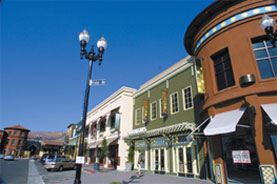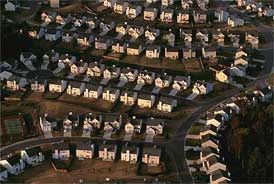National Geographic has a really cool image gallery that [compares New Urbanist and Sprawl suburbs [NG].](http://www.nationalgeographic.com/earthpulse/sprawl/gallery1.html) Wait a sec…National Geographic? [Here’s a cheesy interactive page of the same info [NG].](http://www.nationalgeographic.com/earthpulse/sprawl/index_flash.html)
* New Urbanism – [promotes the creation and restoration of diverse, walkable, compact, vibrant, mixed-use communities composed of the same components as conventional development, but assembled in a more integrated fashion, in the form of complete communities [newurbanism.org].](http://www.newurbanism.org/pages/416429/index.htm)
* Sprawl – [A haphazard and disorderly form of urban development [COA].](http://www.ci.austin.tx.us/zoning/glossary.htm)
Here’s more discussion from the City of Austin:
-Residences far removed from stores, parks, and other activity centers
-Scattered or “leapfrog” development that leaves large tracts of undeveloped land between developments
-Commercial strip development along major streets
-Large expanses of low-density or single use development such as commercial centers with no office or residential uses, or residential areas with no nearby commercial centers
-Major form of transportation is the automobile
Uninterrupted and contiguous low- to medium-density (one to six du/ac) urban development
-Walled residential subdivisions that do not connect to adjacent residential development.
I was specifically interested in National Geographics definition of the residential components and how they differ between the two types of suburban growth:

New Urbanism
* Different housing types—apartments, row houses, detached homes—occupy the same neighborhood, sometimes the same block.
* People of different income levels mingle and may come to better understand each other.
* A family can “move up” without moving away—say, from a row house to a single-family home.
* Property values don’t necessarily suffer when housing types are mixed. New-urbanist neighborhoods are generally outselling neighboring subdivisions, and some of the United States’ most expensive older neighborhoods—Washington, D.C.’s Georgetown, Boston’s Beacon Hill, for example—are marvels of mixed housing.

Sprawl
* Developers often fill whole subdivisions with one type of residence—say, $300,000 ranch houses.
* Zoning often outlaws apartments and houses in the same development.
* Sequestered in a narrow sliver of society, people may develop or maintain intolerance of those outside their ilk.
It seems logical that New Urbanism is more appealing (to me on first glance anyway) based on the points made above, but look at the discussions raised [Suburban Dystopia[Polis]](http://nycenvirons.blogspot.com/2005/12/suburban-dystopia.html). [Suburbs are experiencing a renaissance [LA Times].](http://www.latimes.com/classified/realestate/printedition/la-re-suburb29jan29,0,6957589.story?coll=la-class-realestate) Actually I think nearly every fad or movement in housing is being seen now. When the market is as strong as it has been, more expensive alternatives gain in popularity. Here’s another [California pro-Suburb article that came out on the same day. [SF Chron]](http://sfgate.com/cgi-bin/article.cgi?f=/c/a/2006/01/29/INGHSGSE691.DTL)
The correction of a 50 year old housing pattern is not so easy. In addition, restrictions on use, such as zoning, transportation, building codes, etc. tend to drive the prices up. The move toward New Urbanism means a potentially better living experience but at higher prices.

